Comprehensive Report: Management Accounting Costing and Budgeting
VerifiedAdded on 2019/12/04
|18
|5191
|40
Report
AI Summary
This report delves into the core aspects of management accounting, focusing on costing and budgeting techniques within the context of a food service company, Waitrose. The report begins by classifying different types of costs based on their nature, behavior, and elements. It then explores various costing methods, including job, unit, and absorption costing, and demonstrates how to calculate costs using appropriate techniques. The report also covers the preparation and analysis of routine cost reports, the use of performance indicators to identify potential improvements, and suggestions for cost reduction and value enhancement. Furthermore, it examines the purpose and nature of the budgeting process, selecting suitable budgeting methods, preparing budgets (including a cash budget), and calculating and analyzing variances to propose corrective actions. Finally, the report provides a reconciliation of the operating statement and reporting findings to management.
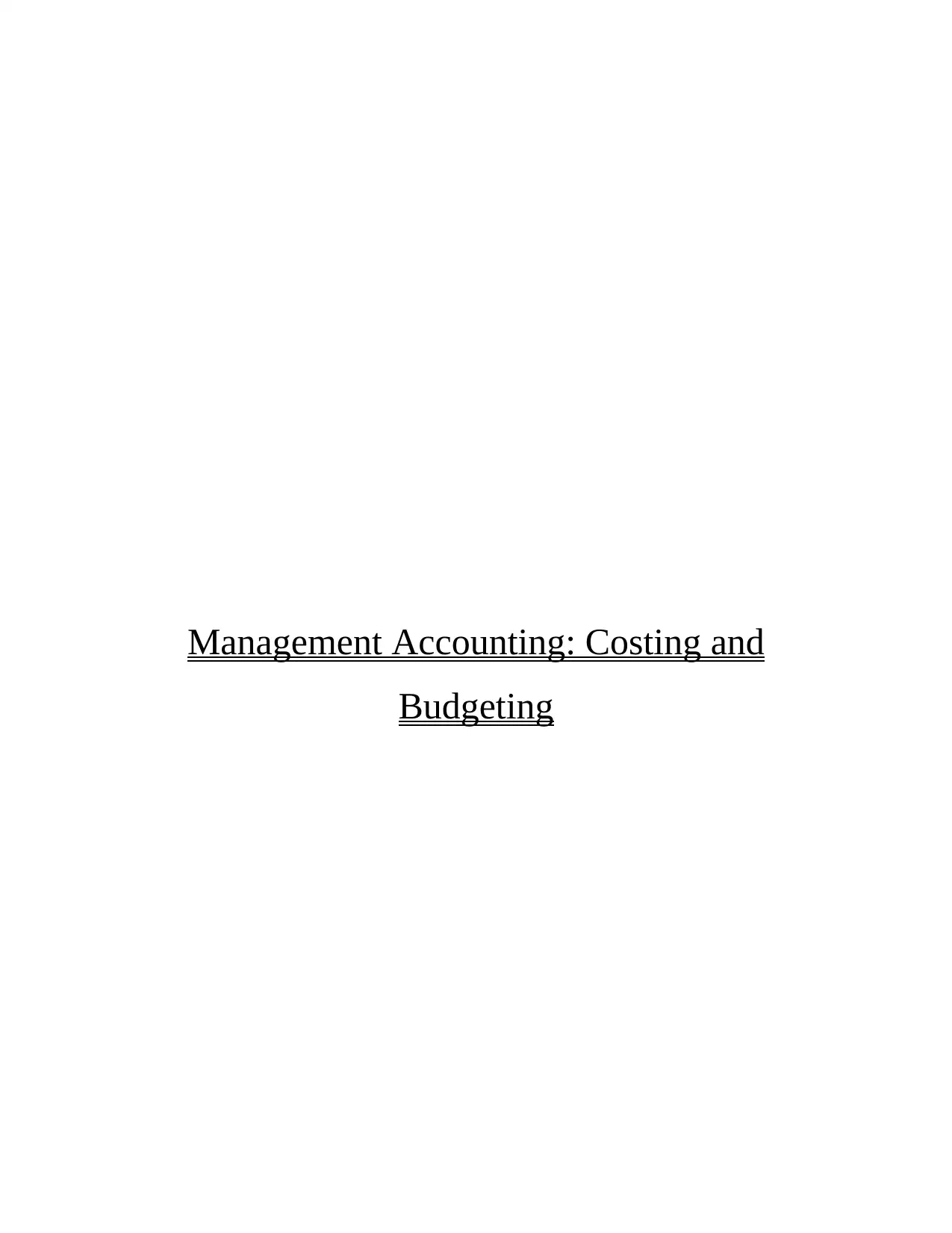
Management Accounting: Costing and
Budgeting
Budgeting
Paraphrase This Document
Need a fresh take? Get an instant paraphrase of this document with our AI Paraphraser
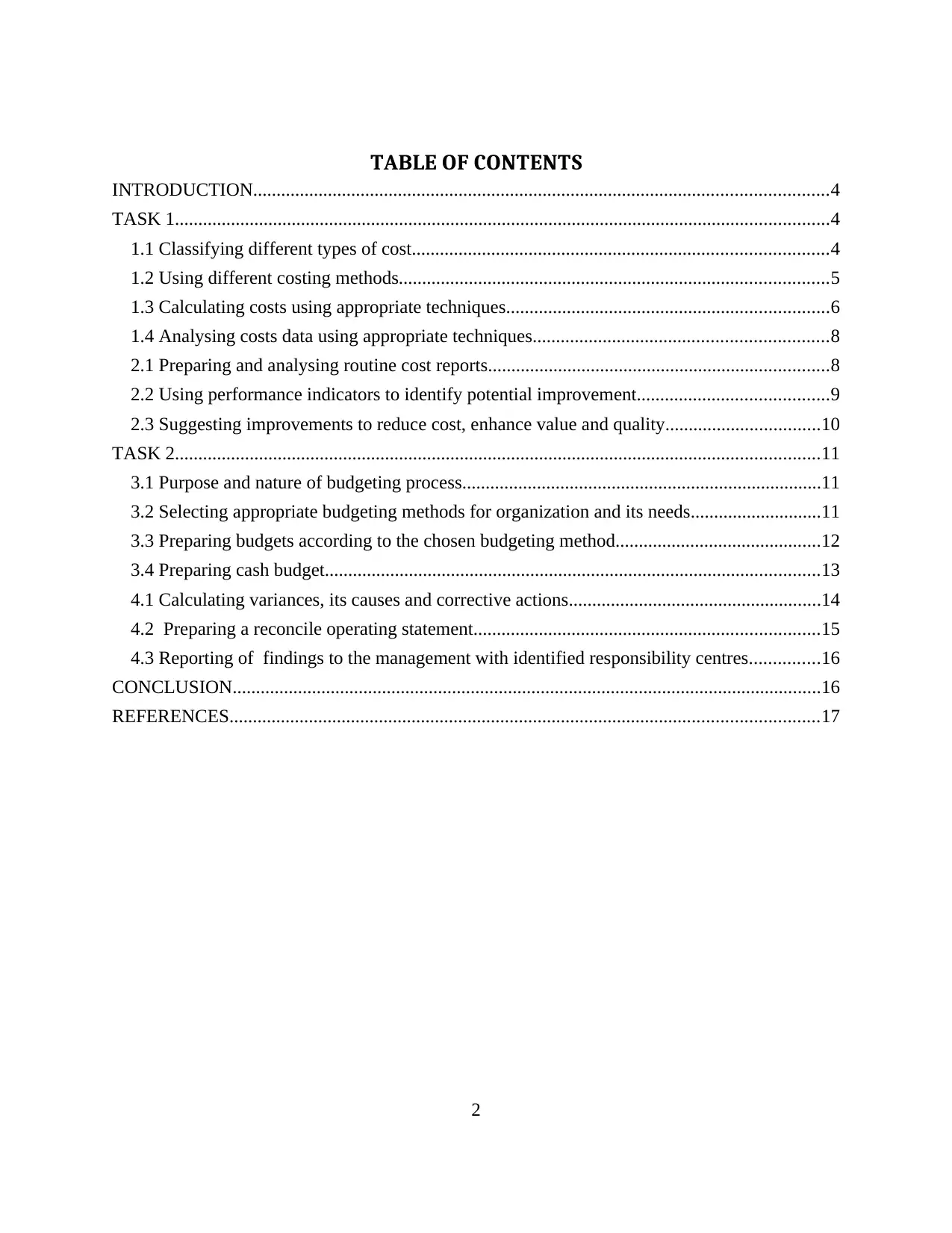
TABLE OF CONTENTS
INTRODUCTION...........................................................................................................................4
TASK 1............................................................................................................................................4
1.1 Classifying different types of cost.........................................................................................4
1.2 Using different costing methods............................................................................................5
1.3 Calculating costs using appropriate techniques.....................................................................6
1.4 Analysing costs data using appropriate techniques...............................................................8
2.1 Preparing and analysing routine cost reports.........................................................................8
2.2 Using performance indicators to identify potential improvement.........................................9
2.3 Suggesting improvements to reduce cost, enhance value and quality.................................10
TASK 2..........................................................................................................................................11
3.1 Purpose and nature of budgeting process.............................................................................11
3.2 Selecting appropriate budgeting methods for organization and its needs............................11
3.3 Preparing budgets according to the chosen budgeting method............................................12
3.4 Preparing cash budget..........................................................................................................13
4.1 Calculating variances, its causes and corrective actions......................................................14
4.2 Preparing a reconcile operating statement..........................................................................15
4.3 Reporting of findings to the management with identified responsibility centres...............16
CONCLUSION..............................................................................................................................16
REFERENCES..............................................................................................................................17
2
INTRODUCTION...........................................................................................................................4
TASK 1............................................................................................................................................4
1.1 Classifying different types of cost.........................................................................................4
1.2 Using different costing methods............................................................................................5
1.3 Calculating costs using appropriate techniques.....................................................................6
1.4 Analysing costs data using appropriate techniques...............................................................8
2.1 Preparing and analysing routine cost reports.........................................................................8
2.2 Using performance indicators to identify potential improvement.........................................9
2.3 Suggesting improvements to reduce cost, enhance value and quality.................................10
TASK 2..........................................................................................................................................11
3.1 Purpose and nature of budgeting process.............................................................................11
3.2 Selecting appropriate budgeting methods for organization and its needs............................11
3.3 Preparing budgets according to the chosen budgeting method............................................12
3.4 Preparing cash budget..........................................................................................................13
4.1 Calculating variances, its causes and corrective actions......................................................14
4.2 Preparing a reconcile operating statement..........................................................................15
4.3 Reporting of findings to the management with identified responsibility centres...............16
CONCLUSION..............................................................................................................................16
REFERENCES..............................................................................................................................17
2
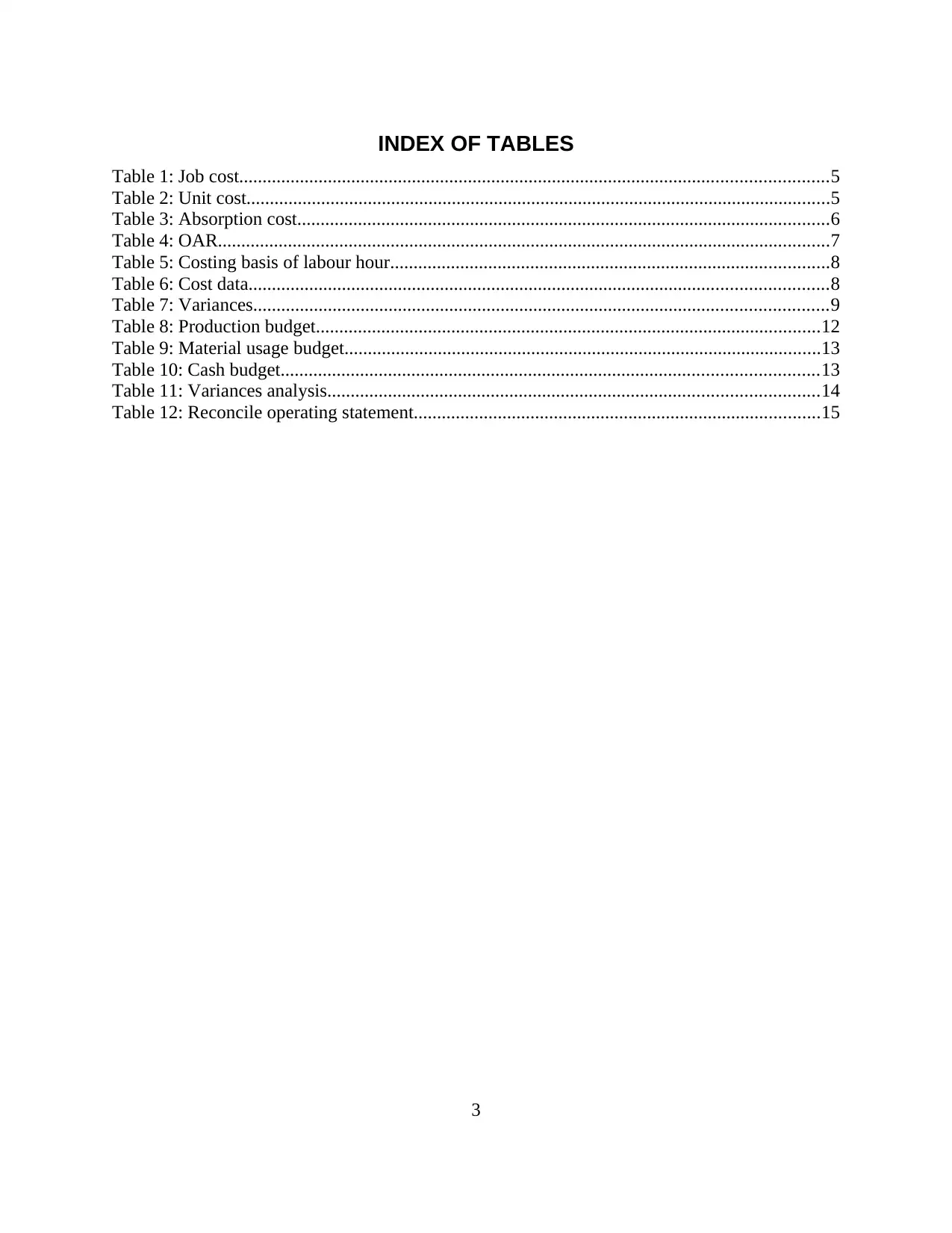
INDEX OF TABLES
Table 1: Job cost..............................................................................................................................5
Table 2: Unit cost.............................................................................................................................5
Table 3: Absorption cost..................................................................................................................6
Table 4: OAR...................................................................................................................................7
Table 5: Costing basis of labour hour..............................................................................................8
Table 6: Cost data............................................................................................................................8
Table 7: Variances...........................................................................................................................9
Table 8: Production budget............................................................................................................12
Table 9: Material usage budget......................................................................................................13
Table 10: Cash budget...................................................................................................................13
Table 11: Variances analysis.........................................................................................................14
Table 12: Reconcile operating statement.......................................................................................15
3
Table 1: Job cost..............................................................................................................................5
Table 2: Unit cost.............................................................................................................................5
Table 3: Absorption cost..................................................................................................................6
Table 4: OAR...................................................................................................................................7
Table 5: Costing basis of labour hour..............................................................................................8
Table 6: Cost data............................................................................................................................8
Table 7: Variances...........................................................................................................................9
Table 8: Production budget............................................................................................................12
Table 9: Material usage budget......................................................................................................13
Table 10: Cash budget...................................................................................................................13
Table 11: Variances analysis.........................................................................................................14
Table 12: Reconcile operating statement.......................................................................................15
3
⊘ This is a preview!⊘
Do you want full access?
Subscribe today to unlock all pages.

Trusted by 1+ million students worldwide
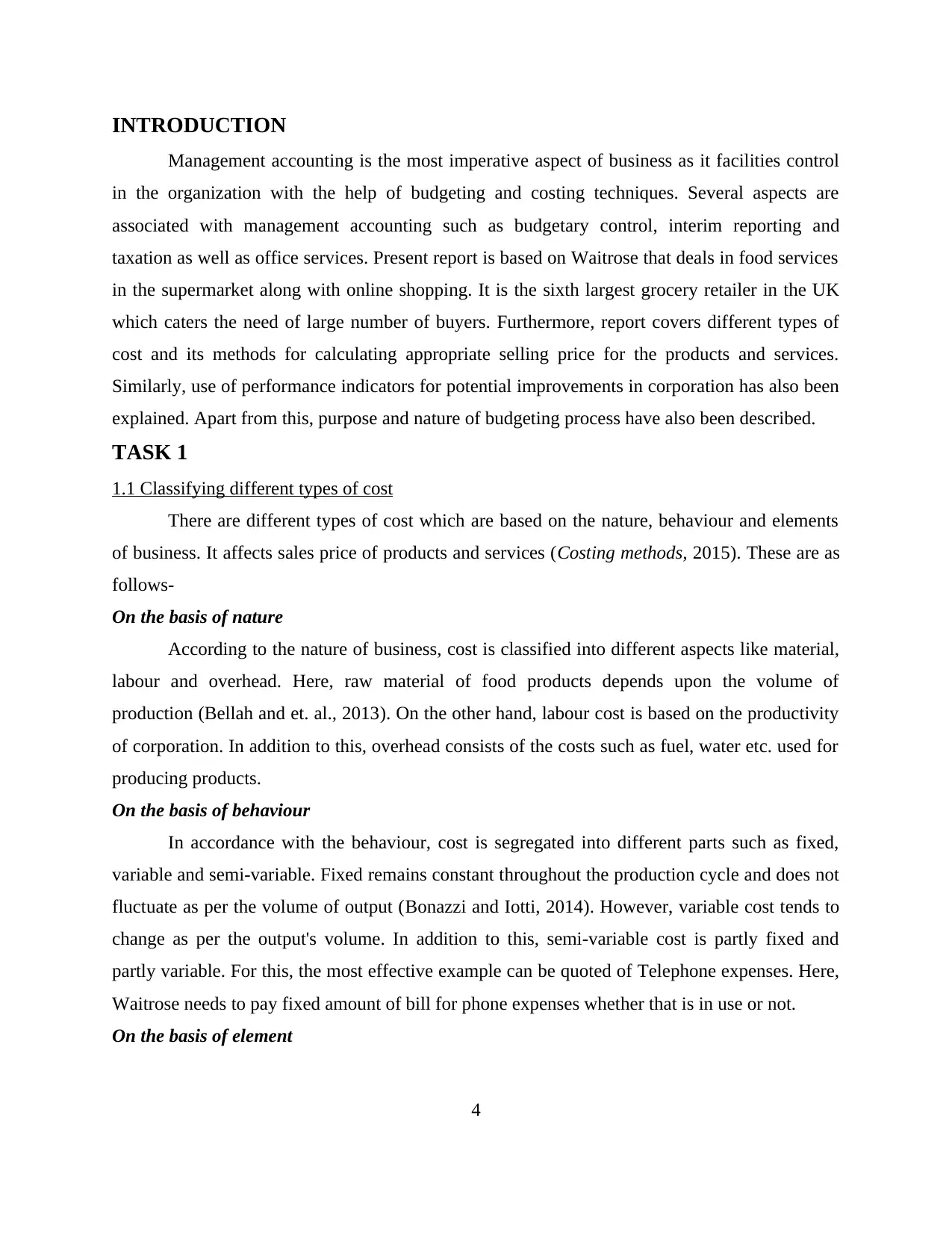
INTRODUCTION
Management accounting is the most imperative aspect of business as it facilities control
in the organization with the help of budgeting and costing techniques. Several aspects are
associated with management accounting such as budgetary control, interim reporting and
taxation as well as office services. Present report is based on Waitrose that deals in food services
in the supermarket along with online shopping. It is the sixth largest grocery retailer in the UK
which caters the need of large number of buyers. Furthermore, report covers different types of
cost and its methods for calculating appropriate selling price for the products and services.
Similarly, use of performance indicators for potential improvements in corporation has also been
explained. Apart from this, purpose and nature of budgeting process have also been described.
TASK 1
1.1 Classifying different types of cost
There are different types of cost which are based on the nature, behaviour and elements
of business. It affects sales price of products and services (Costing methods, 2015). These are as
follows-
On the basis of nature
According to the nature of business, cost is classified into different aspects like material,
labour and overhead. Here, raw material of food products depends upon the volume of
production (Bellah and et. al., 2013). On the other hand, labour cost is based on the productivity
of corporation. In addition to this, overhead consists of the costs such as fuel, water etc. used for
producing products.
On the basis of behaviour
In accordance with the behaviour, cost is segregated into different parts such as fixed,
variable and semi-variable. Fixed remains constant throughout the production cycle and does not
fluctuate as per the volume of output (Bonazzi and Iotti, 2014). However, variable cost tends to
change as per the output's volume. In addition to this, semi-variable cost is partly fixed and
partly variable. For this, the most effective example can be quoted of Telephone expenses. Here,
Waitrose needs to pay fixed amount of bill for phone expenses whether that is in use or not.
On the basis of element
4
Management accounting is the most imperative aspect of business as it facilities control
in the organization with the help of budgeting and costing techniques. Several aspects are
associated with management accounting such as budgetary control, interim reporting and
taxation as well as office services. Present report is based on Waitrose that deals in food services
in the supermarket along with online shopping. It is the sixth largest grocery retailer in the UK
which caters the need of large number of buyers. Furthermore, report covers different types of
cost and its methods for calculating appropriate selling price for the products and services.
Similarly, use of performance indicators for potential improvements in corporation has also been
explained. Apart from this, purpose and nature of budgeting process have also been described.
TASK 1
1.1 Classifying different types of cost
There are different types of cost which are based on the nature, behaviour and elements
of business. It affects sales price of products and services (Costing methods, 2015). These are as
follows-
On the basis of nature
According to the nature of business, cost is classified into different aspects like material,
labour and overhead. Here, raw material of food products depends upon the volume of
production (Bellah and et. al., 2013). On the other hand, labour cost is based on the productivity
of corporation. In addition to this, overhead consists of the costs such as fuel, water etc. used for
producing products.
On the basis of behaviour
In accordance with the behaviour, cost is segregated into different parts such as fixed,
variable and semi-variable. Fixed remains constant throughout the production cycle and does not
fluctuate as per the volume of output (Bonazzi and Iotti, 2014). However, variable cost tends to
change as per the output's volume. In addition to this, semi-variable cost is partly fixed and
partly variable. For this, the most effective example can be quoted of Telephone expenses. Here,
Waitrose needs to pay fixed amount of bill for phone expenses whether that is in use or not.
On the basis of element
4
Paraphrase This Document
Need a fresh take? Get an instant paraphrase of this document with our AI Paraphraser
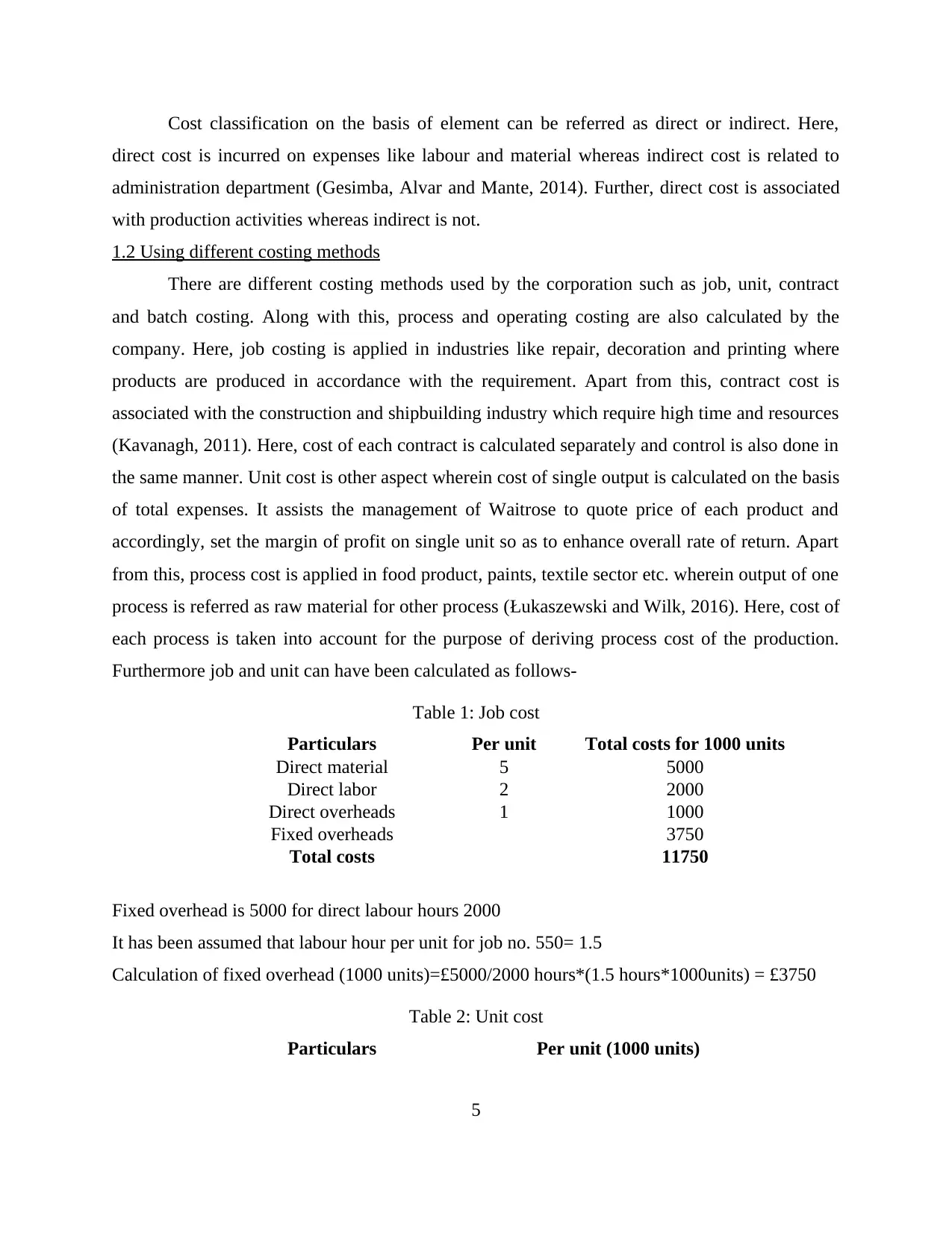
Cost classification on the basis of element can be referred as direct or indirect. Here,
direct cost is incurred on expenses like labour and material whereas indirect cost is related to
administration department (Gesimba, Alvar and Mante, 2014). Further, direct cost is associated
with production activities whereas indirect is not.
1.2 Using different costing methods
There are different costing methods used by the corporation such as job, unit, contract
and batch costing. Along with this, process and operating costing are also calculated by the
company. Here, job costing is applied in industries like repair, decoration and printing where
products are produced in accordance with the requirement. Apart from this, contract cost is
associated with the construction and shipbuilding industry which require high time and resources
(Kavanagh, 2011). Here, cost of each contract is calculated separately and control is also done in
the same manner. Unit cost is other aspect wherein cost of single output is calculated on the basis
of total expenses. It assists the management of Waitrose to quote price of each product and
accordingly, set the margin of profit on single unit so as to enhance overall rate of return. Apart
from this, process cost is applied in food product, paints, textile sector etc. wherein output of one
process is referred as raw material for other process (Łukaszewski and Wilk, 2016). Here, cost of
each process is taken into account for the purpose of deriving process cost of the production.
Furthermore job and unit can have been calculated as follows-
Table 1: Job cost
Particulars Per unit Total costs for 1000 units
Direct material 5 5000
Direct labor 2 2000
Direct overheads 1 1000
Fixed overheads 3750
Total costs 11750
Fixed overhead is 5000 for direct labour hours 2000
It has been assumed that labour hour per unit for job no. 550= 1.5
Calculation of fixed overhead (1000 units)=£5000/2000 hours*(1.5 hours*1000units) = £3750
Table 2: Unit cost
Particulars Per unit (1000 units)
5
direct cost is incurred on expenses like labour and material whereas indirect cost is related to
administration department (Gesimba, Alvar and Mante, 2014). Further, direct cost is associated
with production activities whereas indirect is not.
1.2 Using different costing methods
There are different costing methods used by the corporation such as job, unit, contract
and batch costing. Along with this, process and operating costing are also calculated by the
company. Here, job costing is applied in industries like repair, decoration and printing where
products are produced in accordance with the requirement. Apart from this, contract cost is
associated with the construction and shipbuilding industry which require high time and resources
(Kavanagh, 2011). Here, cost of each contract is calculated separately and control is also done in
the same manner. Unit cost is other aspect wherein cost of single output is calculated on the basis
of total expenses. It assists the management of Waitrose to quote price of each product and
accordingly, set the margin of profit on single unit so as to enhance overall rate of return. Apart
from this, process cost is applied in food product, paints, textile sector etc. wherein output of one
process is referred as raw material for other process (Łukaszewski and Wilk, 2016). Here, cost of
each process is taken into account for the purpose of deriving process cost of the production.
Furthermore job and unit can have been calculated as follows-
Table 1: Job cost
Particulars Per unit Total costs for 1000 units
Direct material 5 5000
Direct labor 2 2000
Direct overheads 1 1000
Fixed overheads 3750
Total costs 11750
Fixed overhead is 5000 for direct labour hours 2000
It has been assumed that labour hour per unit for job no. 550= 1.5
Calculation of fixed overhead (1000 units)=£5000/2000 hours*(1.5 hours*1000units) = £3750
Table 2: Unit cost
Particulars Per unit (1000 units)
5

Direct material 5
Direct labor 2
Direct overheads 1
Fixed overheads 3.75
Total costs
Unit cost of products has been calculated in above mentioned table. It reflects that per
unit cost of product will be 11.75. This is calculated through dividing total production cost with
the number of units. For example- £11750/1000 units = £11.75. Hence, total cost per unit
required is 11.75.
1.3 Calculating costs using appropriate techniques
The appropriate technique of cost calculation are explained as follows-
Absorption costing-This is another effective aspect of cost calculation which provides
detail related to fixed and variance cost that are associated with products and services. It
serves as the classification of cost among different sector (Parmenter, 2015).
Table 3: Absorption cost
Basis of
allocati
on Ratio Production department
Service
departments Total
Machinery 1
Machinery
2 Stores
Mainten
ance
Indirect
material 200000 225000 425000
Indirect wages 150000 160000 310000
Light and
heating
depart
ment
wise
occupie
d area (2:1:1:1) 37500 18750 18750 18750 75000
Insurance of machin (1:1:0.5:0.5) 5000 5000 2500 2500 15000
6
Direct labor 2
Direct overheads 1
Fixed overheads 3.75
Total costs
Unit cost of products has been calculated in above mentioned table. It reflects that per
unit cost of product will be 11.75. This is calculated through dividing total production cost with
the number of units. For example- £11750/1000 units = £11.75. Hence, total cost per unit
required is 11.75.
1.3 Calculating costs using appropriate techniques
The appropriate technique of cost calculation are explained as follows-
Absorption costing-This is another effective aspect of cost calculation which provides
detail related to fixed and variance cost that are associated with products and services. It
serves as the classification of cost among different sector (Parmenter, 2015).
Table 3: Absorption cost
Basis of
allocati
on Ratio Production department
Service
departments Total
Machinery 1
Machinery
2 Stores
Mainten
ance
Indirect
material 200000 225000 425000
Indirect wages 150000 160000 310000
Light and
heating
depart
ment
wise
occupie
d area (2:1:1:1) 37500 18750 18750 18750 75000
Insurance of machin (1:1:0.5:0.5) 5000 5000 2500 2500 15000
6
⊘ This is a preview!⊘
Do you want full access?
Subscribe today to unlock all pages.

Trusted by 1+ million students worldwide
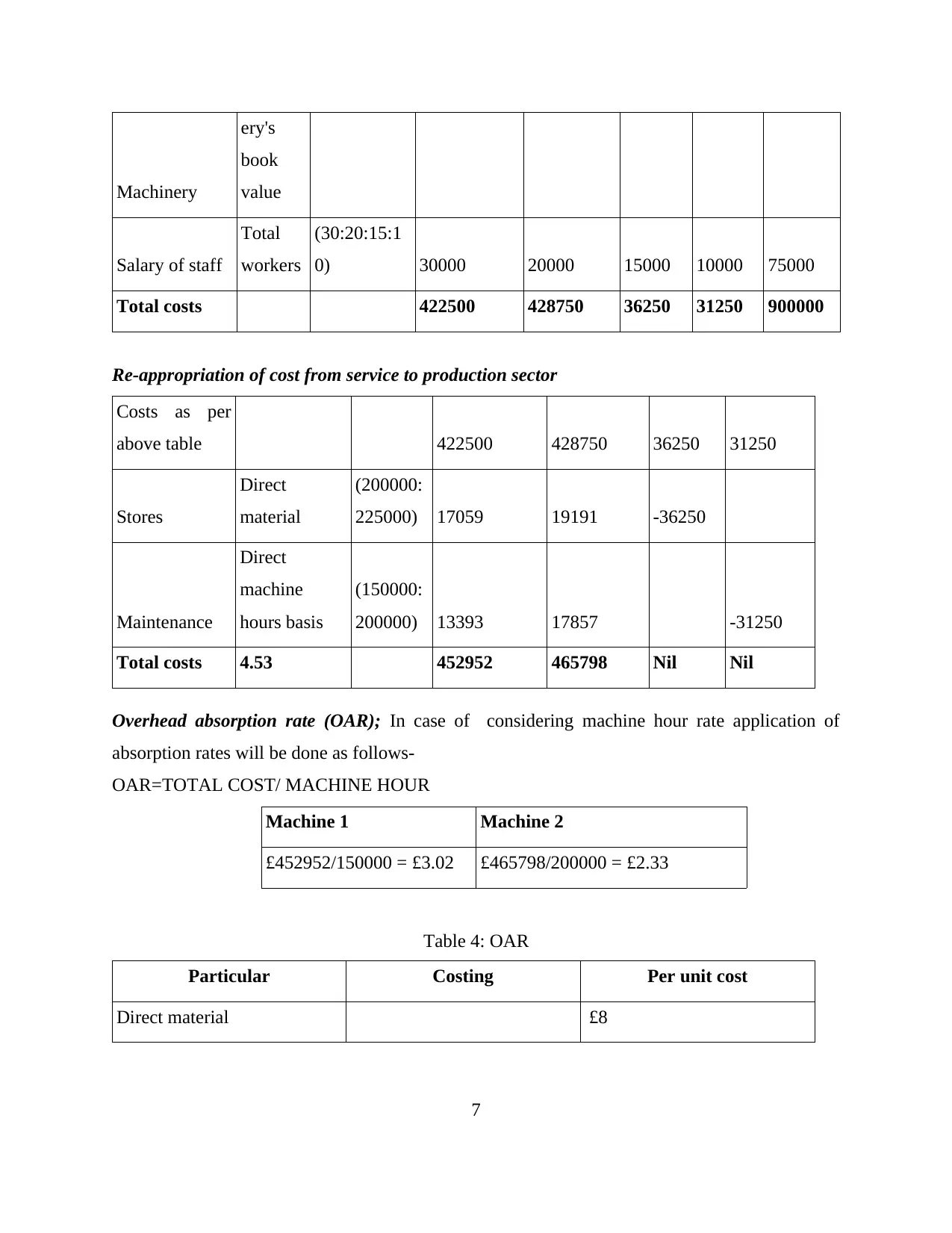
Machinery
ery's
book
value
Salary of staff
Total
workers
(30:20:15:1
0) 30000 20000 15000 10000 75000
Total costs 422500 428750 36250 31250 900000
Re-appropriation of cost from service to production sector
Costs as per
above table 422500 428750 36250 31250
Stores
Direct
material
(200000:
225000) 17059 19191 -36250
Maintenance
Direct
machine
hours basis
(150000:
200000) 13393 17857 -31250
Total costs 4.53 452952 465798 Nil Nil
Overhead absorption rate (OAR); In case of considering machine hour rate application of
absorption rates will be done as follows-
OAR=TOTAL COST/ MACHINE HOUR
Machine 1 Machine 2
£452952/150000 = £3.02 £465798/200000 = £2.33
Table 4: OAR
Particular Costing Per unit cost
Direct material £8
7
ery's
book
value
Salary of staff
Total
workers
(30:20:15:1
0) 30000 20000 15000 10000 75000
Total costs 422500 428750 36250 31250 900000
Re-appropriation of cost from service to production sector
Costs as per
above table 422500 428750 36250 31250
Stores
Direct
material
(200000:
225000) 17059 19191 -36250
Maintenance
Direct
machine
hours basis
(150000:
200000) 13393 17857 -31250
Total costs 4.53 452952 465798 Nil Nil
Overhead absorption rate (OAR); In case of considering machine hour rate application of
absorption rates will be done as follows-
OAR=TOTAL COST/ MACHINE HOUR
Machine 1 Machine 2
£452952/150000 = £3.02 £465798/200000 = £2.33
Table 4: OAR
Particular Costing Per unit cost
Direct material £8
7
Paraphrase This Document
Need a fresh take? Get an instant paraphrase of this document with our AI Paraphraser
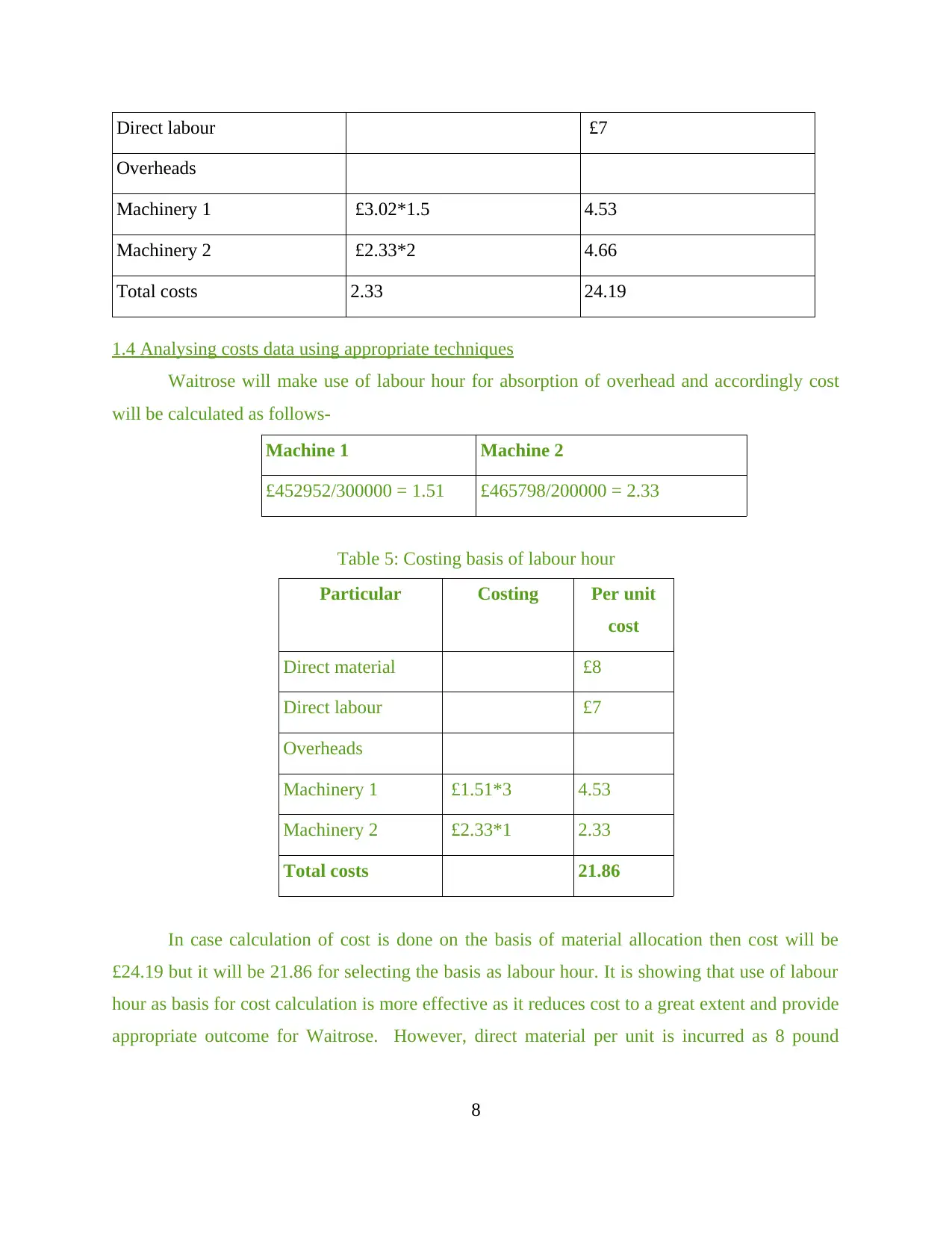
Direct labour £7
Overheads
Machinery 1 £3.02*1.5 4.53
Machinery 2 £2.33*2 4.66
Total costs 2.33 24.19
1.4 Analysing costs data using appropriate techniques
Waitrose will make use of labour hour for absorption of overhead and accordingly cost
will be calculated as follows-
Machine 1 Machine 2
£452952/300000 = 1.51 £465798/200000 = 2.33
Table 5: Costing basis of labour hour
Particular Costing Per unit
cost
Direct material £8
Direct labour £7
Overheads
Machinery 1 £1.51*3 4.53
Machinery 2 £2.33*1 2.33
Total costs 21.86
In case calculation of cost is done on the basis of material allocation then cost will be
£24.19 but it will be 21.86 for selecting the basis as labour hour. It is showing that use of labour
hour as basis for cost calculation is more effective as it reduces cost to a great extent and provide
appropriate outcome for Waitrose. However, direct material per unit is incurred as 8 pound
8
Overheads
Machinery 1 £3.02*1.5 4.53
Machinery 2 £2.33*2 4.66
Total costs 2.33 24.19
1.4 Analysing costs data using appropriate techniques
Waitrose will make use of labour hour for absorption of overhead and accordingly cost
will be calculated as follows-
Machine 1 Machine 2
£452952/300000 = 1.51 £465798/200000 = 2.33
Table 5: Costing basis of labour hour
Particular Costing Per unit
cost
Direct material £8
Direct labour £7
Overheads
Machinery 1 £1.51*3 4.53
Machinery 2 £2.33*1 2.33
Total costs 21.86
In case calculation of cost is done on the basis of material allocation then cost will be
£24.19 but it will be 21.86 for selecting the basis as labour hour. It is showing that use of labour
hour as basis for cost calculation is more effective as it reduces cost to a great extent and provide
appropriate outcome for Waitrose. However, direct material per unit is incurred as 8 pound
8
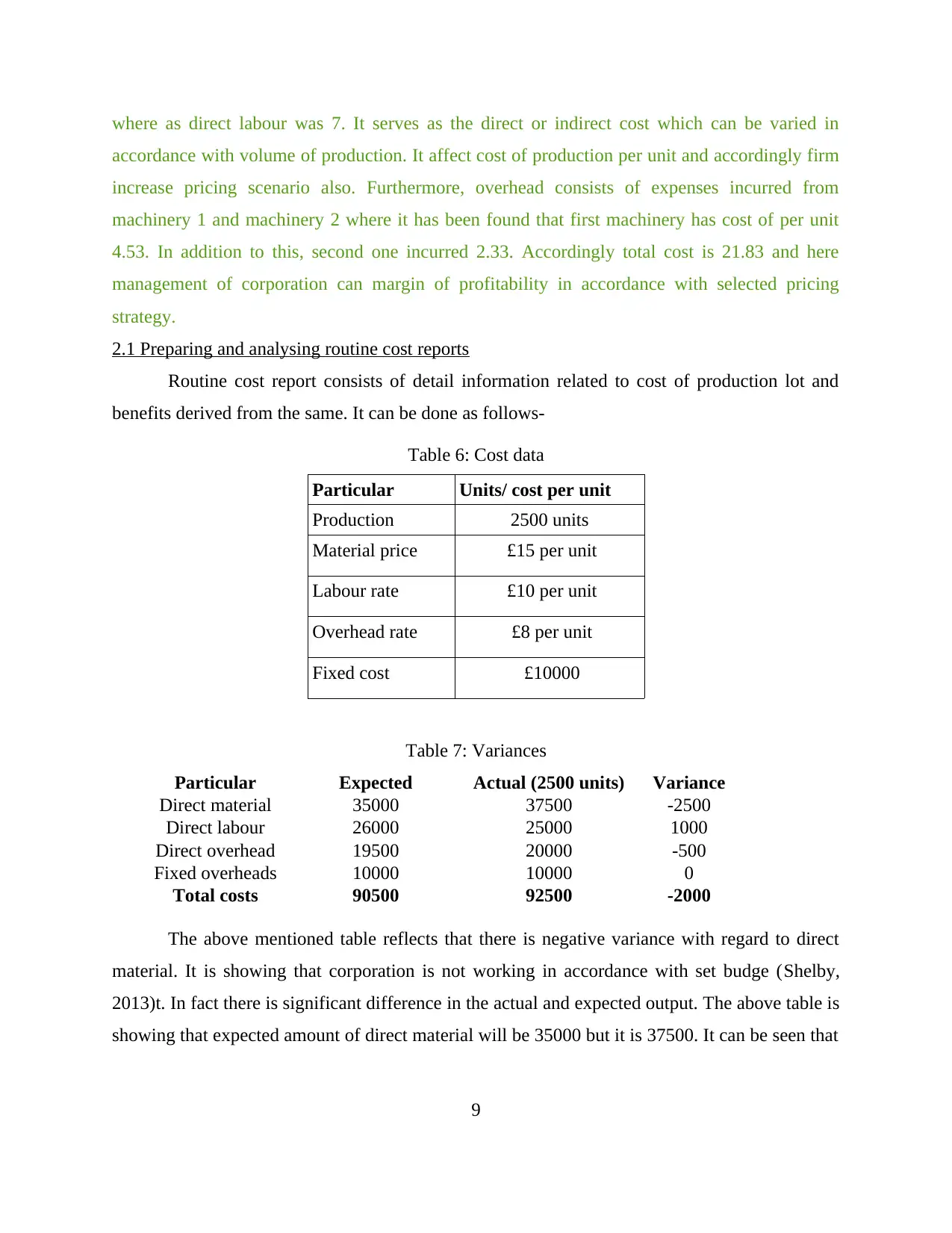
where as direct labour was 7. It serves as the direct or indirect cost which can be varied in
accordance with volume of production. It affect cost of production per unit and accordingly firm
increase pricing scenario also. Furthermore, overhead consists of expenses incurred from
machinery 1 and machinery 2 where it has been found that first machinery has cost of per unit
4.53. In addition to this, second one incurred 2.33. Accordingly total cost is 21.83 and here
management of corporation can margin of profitability in accordance with selected pricing
strategy.
2.1 Preparing and analysing routine cost reports
Routine cost report consists of detail information related to cost of production lot and
benefits derived from the same. It can be done as follows-
Table 6: Cost data
Particular Units/ cost per unit
Production 2500 units
Material price £15 per unit
Labour rate £10 per unit
Overhead rate £8 per unit
Fixed cost £10000
Table 7: Variances
Particular Expected Actual (2500 units) Variance
Direct material 35000 37500 -2500
Direct labour 26000 25000 1000
Direct overhead 19500 20000 -500
Fixed overheads 10000 10000 0
Total costs 90500 92500 -2000
The above mentioned table reflects that there is negative variance with regard to direct
material. It is showing that corporation is not working in accordance with set budge (Shelby,
2013)t. In fact there is significant difference in the actual and expected output. The above table is
showing that expected amount of direct material will be 35000 but it is 37500. It can be seen that
9
accordance with volume of production. It affect cost of production per unit and accordingly firm
increase pricing scenario also. Furthermore, overhead consists of expenses incurred from
machinery 1 and machinery 2 where it has been found that first machinery has cost of per unit
4.53. In addition to this, second one incurred 2.33. Accordingly total cost is 21.83 and here
management of corporation can margin of profitability in accordance with selected pricing
strategy.
2.1 Preparing and analysing routine cost reports
Routine cost report consists of detail information related to cost of production lot and
benefits derived from the same. It can be done as follows-
Table 6: Cost data
Particular Units/ cost per unit
Production 2500 units
Material price £15 per unit
Labour rate £10 per unit
Overhead rate £8 per unit
Fixed cost £10000
Table 7: Variances
Particular Expected Actual (2500 units) Variance
Direct material 35000 37500 -2500
Direct labour 26000 25000 1000
Direct overhead 19500 20000 -500
Fixed overheads 10000 10000 0
Total costs 90500 92500 -2000
The above mentioned table reflects that there is negative variance with regard to direct
material. It is showing that corporation is not working in accordance with set budge (Shelby,
2013)t. In fact there is significant difference in the actual and expected output. The above table is
showing that expected amount of direct material will be 35000 but it is 37500. It can be seen that
9
⊘ This is a preview!⊘
Do you want full access?
Subscribe today to unlock all pages.

Trusted by 1+ million students worldwide
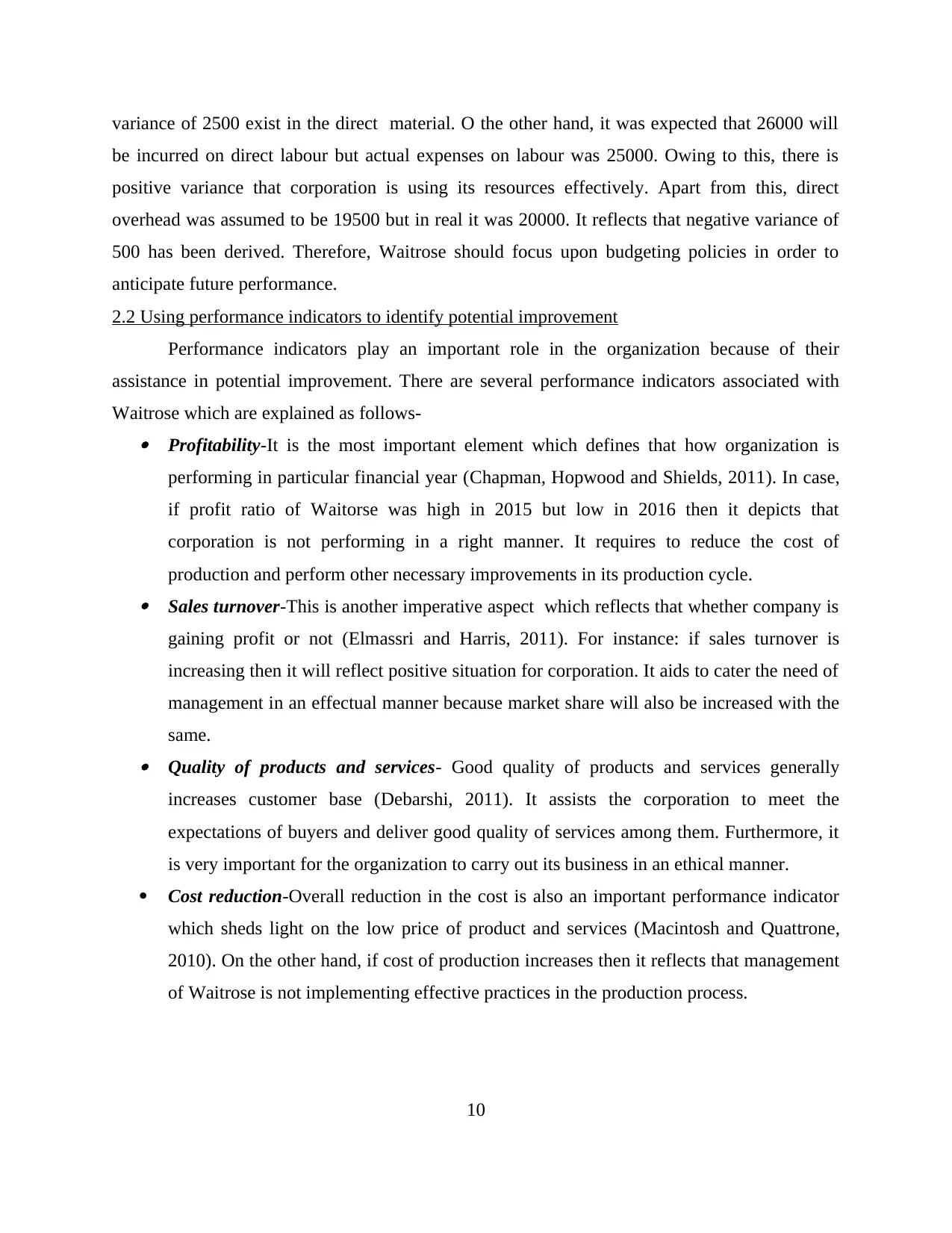
variance of 2500 exist in the direct material. O the other hand, it was expected that 26000 will
be incurred on direct labour but actual expenses on labour was 25000. Owing to this, there is
positive variance that corporation is using its resources effectively. Apart from this, direct
overhead was assumed to be 19500 but in real it was 20000. It reflects that negative variance of
500 has been derived. Therefore, Waitrose should focus upon budgeting policies in order to
anticipate future performance.
2.2 Using performance indicators to identify potential improvement
Performance indicators play an important role in the organization because of their
assistance in potential improvement. There are several performance indicators associated with
Waitrose which are explained as follows- Profitability-It is the most important element which defines that how organization is
performing in particular financial year (Chapman, Hopwood and Shields, 2011). In case,
if profit ratio of Waitorse was high in 2015 but low in 2016 then it depicts that
corporation is not performing in a right manner. It requires to reduce the cost of
production and perform other necessary improvements in its production cycle. Sales turnover-This is another imperative aspect which reflects that whether company is
gaining profit or not (Elmassri and Harris, 2011). For instance: if sales turnover is
increasing then it will reflect positive situation for corporation. It aids to cater the need of
management in an effectual manner because market share will also be increased with the
same. Quality of products and services- Good quality of products and services generally
increases customer base (Debarshi, 2011). It assists the corporation to meet the
expectations of buyers and deliver good quality of services among them. Furthermore, it
is very important for the organization to carry out its business in an ethical manner.
Cost reduction-Overall reduction in the cost is also an important performance indicator
which sheds light on the low price of product and services (Macintosh and Quattrone,
2010). On the other hand, if cost of production increases then it reflects that management
of Waitrose is not implementing effective practices in the production process.
10
be incurred on direct labour but actual expenses on labour was 25000. Owing to this, there is
positive variance that corporation is using its resources effectively. Apart from this, direct
overhead was assumed to be 19500 but in real it was 20000. It reflects that negative variance of
500 has been derived. Therefore, Waitrose should focus upon budgeting policies in order to
anticipate future performance.
2.2 Using performance indicators to identify potential improvement
Performance indicators play an important role in the organization because of their
assistance in potential improvement. There are several performance indicators associated with
Waitrose which are explained as follows- Profitability-It is the most important element which defines that how organization is
performing in particular financial year (Chapman, Hopwood and Shields, 2011). In case,
if profit ratio of Waitorse was high in 2015 but low in 2016 then it depicts that
corporation is not performing in a right manner. It requires to reduce the cost of
production and perform other necessary improvements in its production cycle. Sales turnover-This is another imperative aspect which reflects that whether company is
gaining profit or not (Elmassri and Harris, 2011). For instance: if sales turnover is
increasing then it will reflect positive situation for corporation. It aids to cater the need of
management in an effectual manner because market share will also be increased with the
same. Quality of products and services- Good quality of products and services generally
increases customer base (Debarshi, 2011). It assists the corporation to meet the
expectations of buyers and deliver good quality of services among them. Furthermore, it
is very important for the organization to carry out its business in an ethical manner.
Cost reduction-Overall reduction in the cost is also an important performance indicator
which sheds light on the low price of product and services (Macintosh and Quattrone,
2010). On the other hand, if cost of production increases then it reflects that management
of Waitrose is not implementing effective practices in the production process.
10
Paraphrase This Document
Need a fresh take? Get an instant paraphrase of this document with our AI Paraphraser
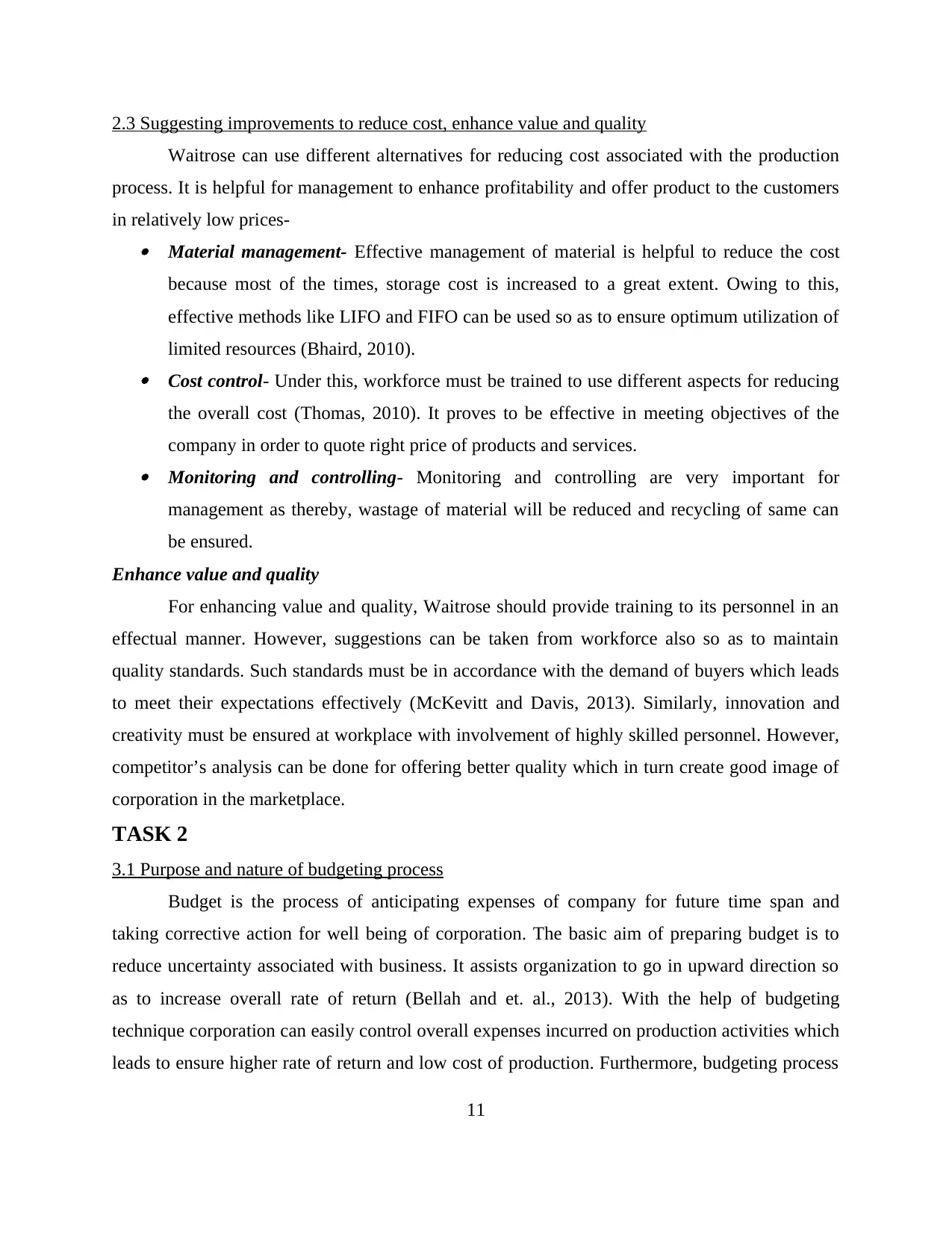
2.3 Suggesting improvements to reduce cost, enhance value and quality
Waitrose can use different alternatives for reducing cost associated with the production
process. It is helpful for management to enhance profitability and offer product to the customers
in relatively low prices- Material management- Effective management of material is helpful to reduce the cost
because most of the times, storage cost is increased to a great extent. Owing to this,
effective methods like LIFO and FIFO can be used so as to ensure optimum utilization of
limited resources (Bhaird, 2010). Cost control- Under this, workforce must be trained to use different aspects for reducing
the overall cost (Thomas, 2010). It proves to be effective in meeting objectives of the
company in order to quote right price of products and services. Monitoring and controlling- Monitoring and controlling are very important for
management as thereby, wastage of material will be reduced and recycling of same can
be ensured.
Enhance value and quality
For enhancing value and quality, Waitrose should provide training to its personnel in an
effectual manner. However, suggestions can be taken from workforce also so as to maintain
quality standards. Such standards must be in accordance with the demand of buyers which leads
to meet their expectations effectively (McKevitt and Davis, 2013). Similarly, innovation and
creativity must be ensured at workplace with involvement of highly skilled personnel. However,
competitor’s analysis can be done for offering better quality which in turn create good image of
corporation in the marketplace.
TASK 2
3.1 Purpose and nature of budgeting process
Budget is the process of anticipating expenses of company for future time span and
taking corrective action for well being of corporation. The basic aim of preparing budget is to
reduce uncertainty associated with business. It assists organization to go in upward direction so
as to increase overall rate of return (Bellah and et. al., 2013). With the help of budgeting
technique corporation can easily control overall expenses incurred on production activities which
leads to ensure higher rate of return and low cost of production. Furthermore, budgeting process
11
Waitrose can use different alternatives for reducing cost associated with the production
process. It is helpful for management to enhance profitability and offer product to the customers
in relatively low prices- Material management- Effective management of material is helpful to reduce the cost
because most of the times, storage cost is increased to a great extent. Owing to this,
effective methods like LIFO and FIFO can be used so as to ensure optimum utilization of
limited resources (Bhaird, 2010). Cost control- Under this, workforce must be trained to use different aspects for reducing
the overall cost (Thomas, 2010). It proves to be effective in meeting objectives of the
company in order to quote right price of products and services. Monitoring and controlling- Monitoring and controlling are very important for
management as thereby, wastage of material will be reduced and recycling of same can
be ensured.
Enhance value and quality
For enhancing value and quality, Waitrose should provide training to its personnel in an
effectual manner. However, suggestions can be taken from workforce also so as to maintain
quality standards. Such standards must be in accordance with the demand of buyers which leads
to meet their expectations effectively (McKevitt and Davis, 2013). Similarly, innovation and
creativity must be ensured at workplace with involvement of highly skilled personnel. However,
competitor’s analysis can be done for offering better quality which in turn create good image of
corporation in the marketplace.
TASK 2
3.1 Purpose and nature of budgeting process
Budget is the process of anticipating expenses of company for future time span and
taking corrective action for well being of corporation. The basic aim of preparing budget is to
reduce uncertainty associated with business. It assists organization to go in upward direction so
as to increase overall rate of return (Bellah and et. al., 2013). With the help of budgeting
technique corporation can easily control overall expenses incurred on production activities which
leads to ensure higher rate of return and low cost of production. Furthermore, budgeting process
11
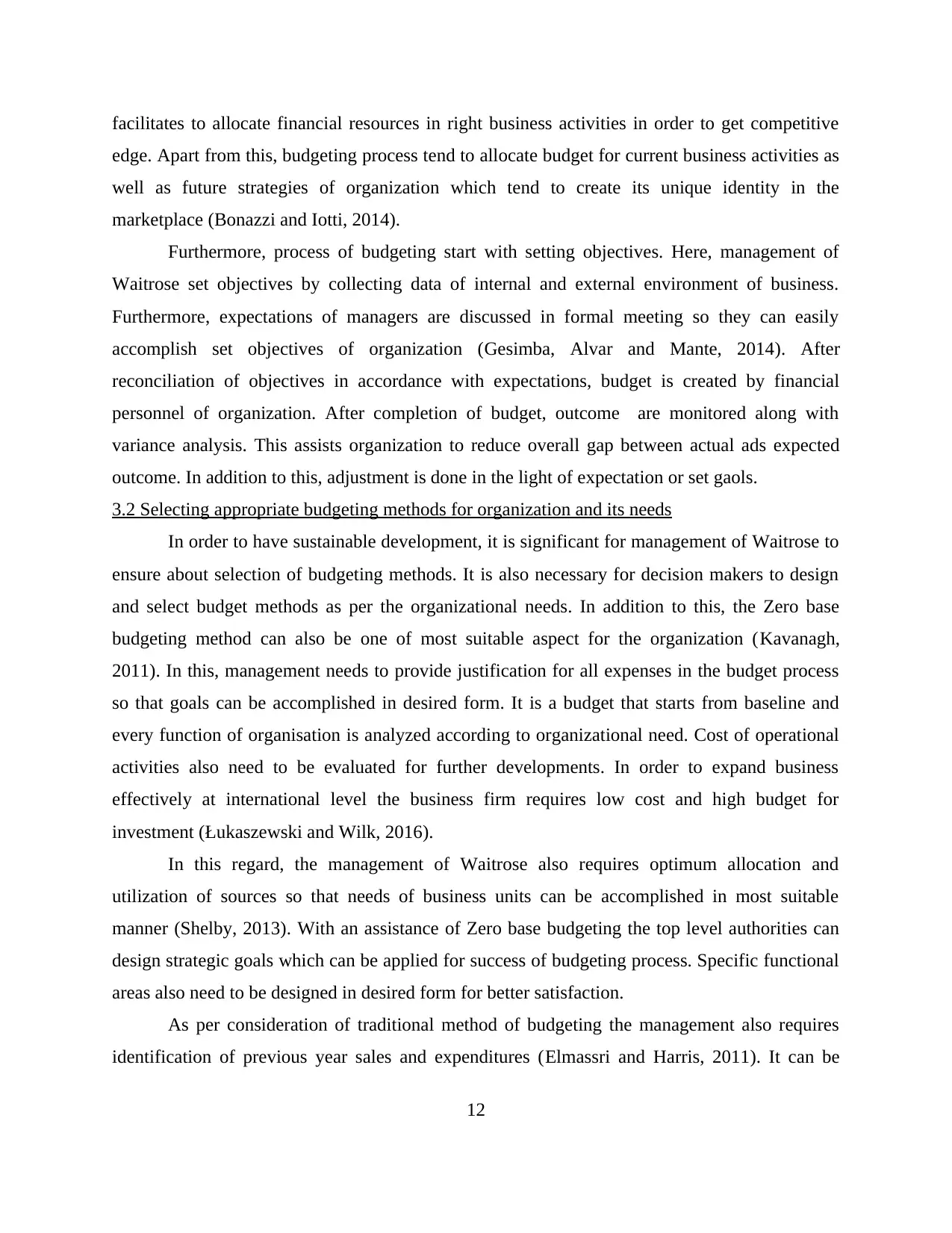
facilitates to allocate financial resources in right business activities in order to get competitive
edge. Apart from this, budgeting process tend to allocate budget for current business activities as
well as future strategies of organization which tend to create its unique identity in the
marketplace (Bonazzi and Iotti, 2014).
Furthermore, process of budgeting start with setting objectives. Here, management of
Waitrose set objectives by collecting data of internal and external environment of business.
Furthermore, expectations of managers are discussed in formal meeting so they can easily
accomplish set objectives of organization (Gesimba, Alvar and Mante, 2014). After
reconciliation of objectives in accordance with expectations, budget is created by financial
personnel of organization. After completion of budget, outcome are monitored along with
variance analysis. This assists organization to reduce overall gap between actual ads expected
outcome. In addition to this, adjustment is done in the light of expectation or set gaols.
3.2 Selecting appropriate budgeting methods for organization and its needs
In order to have sustainable development, it is significant for management of Waitrose to
ensure about selection of budgeting methods. It is also necessary for decision makers to design
and select budget methods as per the organizational needs. In addition to this, the Zero base
budgeting method can also be one of most suitable aspect for the organization (Kavanagh,
2011). In this, management needs to provide justification for all expenses in the budget process
so that goals can be accomplished in desired form. It is a budget that starts from baseline and
every function of organisation is analyzed according to organizational need. Cost of operational
activities also need to be evaluated for further developments. In order to expand business
effectively at international level the business firm requires low cost and high budget for
investment (Łukaszewski and Wilk, 2016).
In this regard, the management of Waitrose also requires optimum allocation and
utilization of sources so that needs of business units can be accomplished in most suitable
manner (Shelby, 2013). With an assistance of Zero base budgeting the top level authorities can
design strategic goals which can be applied for success of budgeting process. Specific functional
areas also need to be designed in desired form for better satisfaction.
As per consideration of traditional method of budgeting the management also requires
identification of previous year sales and expenditures (Elmassri and Harris, 2011). It can be
12
edge. Apart from this, budgeting process tend to allocate budget for current business activities as
well as future strategies of organization which tend to create its unique identity in the
marketplace (Bonazzi and Iotti, 2014).
Furthermore, process of budgeting start with setting objectives. Here, management of
Waitrose set objectives by collecting data of internal and external environment of business.
Furthermore, expectations of managers are discussed in formal meeting so they can easily
accomplish set objectives of organization (Gesimba, Alvar and Mante, 2014). After
reconciliation of objectives in accordance with expectations, budget is created by financial
personnel of organization. After completion of budget, outcome are monitored along with
variance analysis. This assists organization to reduce overall gap between actual ads expected
outcome. In addition to this, adjustment is done in the light of expectation or set gaols.
3.2 Selecting appropriate budgeting methods for organization and its needs
In order to have sustainable development, it is significant for management of Waitrose to
ensure about selection of budgeting methods. It is also necessary for decision makers to design
and select budget methods as per the organizational needs. In addition to this, the Zero base
budgeting method can also be one of most suitable aspect for the organization (Kavanagh,
2011). In this, management needs to provide justification for all expenses in the budget process
so that goals can be accomplished in desired form. It is a budget that starts from baseline and
every function of organisation is analyzed according to organizational need. Cost of operational
activities also need to be evaluated for further developments. In order to expand business
effectively at international level the business firm requires low cost and high budget for
investment (Łukaszewski and Wilk, 2016).
In this regard, the management of Waitrose also requires optimum allocation and
utilization of sources so that needs of business units can be accomplished in most suitable
manner (Shelby, 2013). With an assistance of Zero base budgeting the top level authorities can
design strategic goals which can be applied for success of budgeting process. Specific functional
areas also need to be designed in desired form for better satisfaction.
As per consideration of traditional method of budgeting the management also requires
identification of previous year sales and expenditures (Elmassri and Harris, 2011). It can be
12
⊘ This is a preview!⊘
Do you want full access?
Subscribe today to unlock all pages.

Trusted by 1+ million students worldwide
1 out of 18
Related Documents
Your All-in-One AI-Powered Toolkit for Academic Success.
+13062052269
info@desklib.com
Available 24*7 on WhatsApp / Email
![[object Object]](/_next/static/media/star-bottom.7253800d.svg)
Unlock your academic potential
Copyright © 2020–2025 A2Z Services. All Rights Reserved. Developed and managed by ZUCOL.





